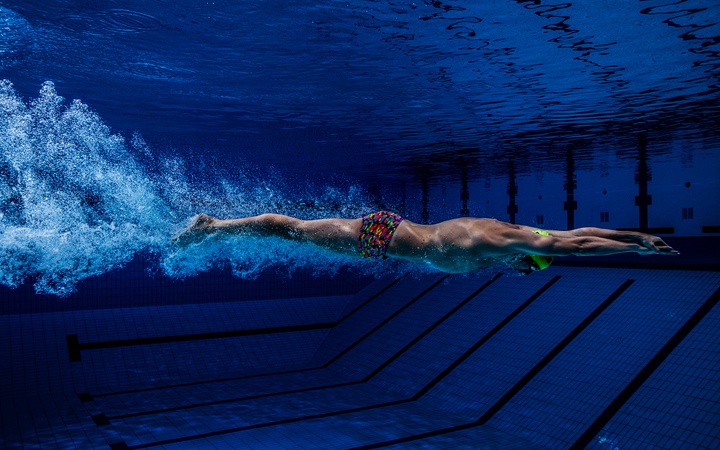Courtesy of Gary Hall Sr., 10-time World Record Holder, 3-time Olympian, 1976 Olympic Games US Flagbearer and The Race Club co-founder.
The amount of propulsion generated by the kick is arguably the most important difference among fast and not-so-fast swimmers. While the motions involved in the propulsion for freestyle, butterfly and backstroke kicks are similar, the breaststroke kick requires an entirely different set of physical attributes. For now, we will focus on freestyle or flutter kick.
As with the pull, the propulsion generated by the kick depends on the amount of surface area of the foot and the speed of that surface pushing backward (relative to the water). Unlike the pull, where the water in front of the hand moving backward is relatively still, the flow dynamics behind the swimmer (vortices) contribute significantly to the amount of propulsion generated by the foot.
There are three articulations involved in the freestyle kick; the hip, the knee and the ankle. To kick fast, they all need to be just right. As with the pulling motion, the ideal kicking motion must reach a compromise between the propulsive forces and the frontal drag forces.
The saying ‘bend but don’t break’ could not apply more appropriately than with the kicking motion. Having plantar flexibility of the ankle is the single most important physical attribute of a fast kicker. With greater plantar flexibility of the ankle, less knee bend is required to get the same amount of surface area of the top of the foot pushing backward. Some knee bend is required in all fast freestyle kicking, but once the bend of the knee passes around 60 degrees, the system breaks down. The drag coefficient increases dramatically and the swimmer decelerates quickly. A strong kicker with plantar flexibility knows exactly how much to bend the knee on each kick, before snapping the foot backward. A poor kicker with little plantar flexibility will often bend the knee well past 60 degrees in order to get more foot surface area to push backward. In so doing, he nearly comes to a screeching halt. The increase in propulsion he may get from over bending the knee will not offset the deceleration caused by the frontal drag from the knee bend. The resulting inefficient, varying speed does not conform to the law of inertia.
In order to reach the optimal knee bend for maximal kicking speed in freestyle and dolphin, the foot must come out of the water during the up kick. Swimmers with poor plantar flexibility tend to bring the foot too far out of the water. With great freestyle kickers at maximum effort, one sees a virtual boil of water formed behind the swimmer from the continuous hard motion of the foot in both directions. For more on the dynamics of the kick and vortices the foot can create read this Aqua Note.
Yours in Swimming,
Gary Sr.

Gary Hall, Sr., Technical Director and Head Coach of The Race Club (courtesy of TRC)
Like The Race Club on Facebook
Follow The Race Club on Instagram
Follow The Race Club on Twitter
Connect to The Race Club / Gary Hall Sr. on Linkedin
Because Life is Worth Swimming, our mission is to promote swimming through sport, lifelong enjoyment, and good health benefits. Our objective is for each member of and each participant in The Race Club to improve his or her swimming performances, health, and self-esteem through our educational programs, services and creativity. We strive to help each member of The Race Club overcome challenges and reach his or her individual life goals.
The Race Club, logoThe Race Club provides facilities, coaching, training, technical instruction, video, fitness and health programs for swimmers of all ages and abilities. Race Club swim camps are designed and tailored to satisfy each swimmer’s needs, whether one is trying to reach the Olympic Games or simply improve one’s fitness. Our programs are suitable for beginner swimmers, pleasure swimmers, fitness swimmers, USA swimming or YMCA swimmers, or triathletes; anyone who wants to improve swimming skills. All of our Race Club members share an enjoyment of being in the water and use swimming to stimulate a more active mind and body.

